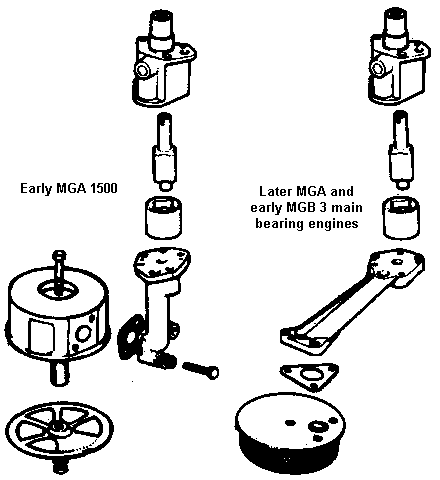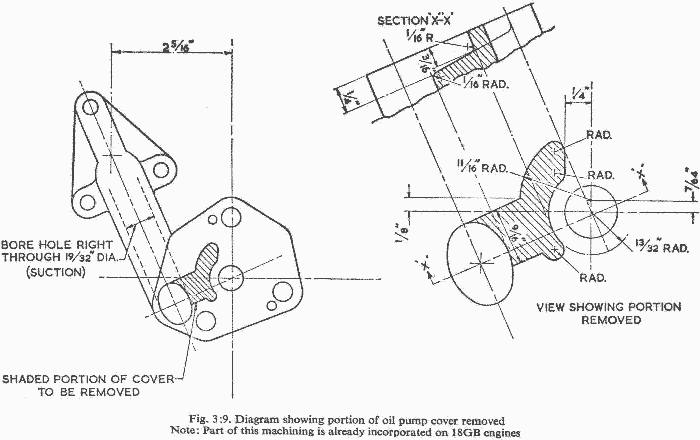The MGA With An Attitude
OIL PUMP MODIFICATION - OF-201
A modification for your oil pump to reduce the flow restriction on the intake side
to eliminate cavitation of the oil pump at high speed.
This is a positive displacement type of pump which displaces almost exactly 1/2 fluid ounce of oil (14.8cc) with each revolution of the input shaft. With the oil pump turning at the same speed as the camshaft, at 7000 rpm crankshaft speed the pump moves an astounding 54 quarts of oil per minute, nearly one quart per second. For an engine with bearings in good condition it only takes about 12 quarts per minute to achieve relief pressure, and any additional flow then passes over the pressure relief valve and directly back into the sump. At this high flow rate the inlet side of the early MGA oil pump is sufficiently restrictive to cause the pump to cavitate at 6500 to 7000 rpm, depending on the viscosity of the oil being used, with higher viscosity oil and/or cold oil giving the worse problem. Cavitation is an empty space vacuum bubble drawn inside of the rotors of the pump, and as soon as this happens the oil flow and pressure both drop instantly to ZERO.
This is a flow restriction problem that mostly plagues the early production MGA through engine number GB46341 (Sept 1958). These engines have (or had) a vertical pickup pipe on the bottom of the oil pump, and a cylindrical sump strainer with the flow connection on the side. This arrangement of parts is somewhat restrictive in the oil flow path on the inlet side of the pump. The bottom end of the pickup pipe inside of the strainer is very close to the bottom of the oil pan, and if you happen to get a slight dent in the bottom of the pan it can get even closer. The pickup tube does a 90 degree curve to the connection on the side of the strainer. Then the flow path does a sharp 90 degree turn upwards in the bottom end of the pump pickup arm. From there the oil flows upwards through the drilling in the bottom arm, and continues upward through a drilling in the side of the pump housing. At the interface with the top plate the oil makes another sharp 90 degree turn to enter the inlet port at the top of the pump internal rotors. The exit port is on the opposite side of the rotors, also in the top of the pump housing.

After Sept 1958 the MGA oil pump was fitted with different pickup arm and sump strainer. The later models have a bowl shape strainer with a flat metal top plate, and the pickup arm on the pump is positioned at about a 45 degree angle such that the inlet oil flow path is a straight line from the bottom end of the pickup tube all the way to the bottom of the pump main housing, and the tube bore size is also somewhat larger than the earlier units. From the bottom of the main pump housing upward the rest of the pump is identical to the earlier units, so these can be converted by just changing the bottom plate and sump strainer. In fact if you are buying a new oil pump you will be getting the later style, because the early type is no longer available, and you will have to use the later type strainer to match. Please do not install the earlier bottom plate on the new pump to save the cost of a new sump strainer. I did this along with the full restoration, and several years later when I took to serious autocrossing at higher engine speed this "false economy" move cost me the failure of the connecting rod bearings, more than once before I caught on to the problem. Simply installing the newer type oil pump and sump strainer should allow your engine to run up to at least 7000 rpm with no problem with pump cavitation. So the very first thing you should do for all of these early MGA engines is to change the oil pump pickup to the later type parts.
Now for those of us lead footed die hard competitors who insist on running the engine regularly to 7000 rpm and higher, there is an additional modification you can do to the oil pump to absolutely insure the it will never run into a cavitation condition. The trick is to machine a second inlet port in the bottom plate of the pump that mirrors the one in the top plate. When the pump has two inlet ports the flow through each port is half of the total flow, and the pressure drop across the port itself is reduced dramatically. Also only half of the oil then has to go through the (smaller) drilling up the side of the pump to the top, so the flow rate and pressure drop is reduced there as well. And enlarging the drill hole in the pickup arm is of additional benefit. The necessary machining dimensions are given in the drawing below. Note that this is the same oil pump that is used on the early MGB three main bearing G and GA engines, so the same information applies to those engines as well.
|

